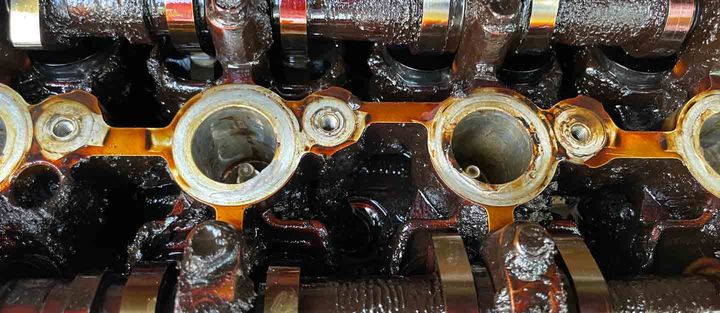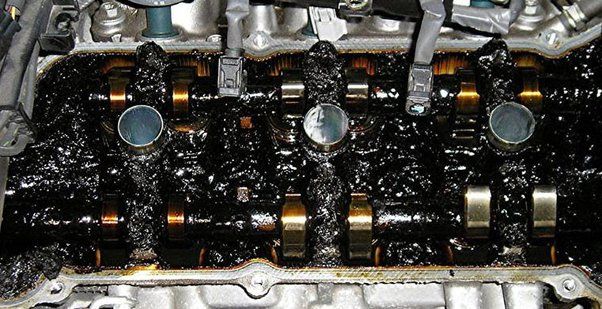


Engine sludge is a thick, tar-like substance that forms when engine oil breaks down and mixes with contaminants such as dirt, fuel, and combustion byproducts. It can clog oil passages, restrict oil flow, and cause excessive wear on engine components, leading to reduced performance and potential engine failure if left unchecked. Cleaning engine sludge is crucial to maintain the health and longevity of your vehicle's engine.
In this article, I'll share my expertise and walk you through the process of identifying, diagnosing, and addressing engine sludge buildup. Whether you're a DIY enthusiast or simply want to understand what's happening under the hood, this guide will provide you with valuable insights and practical steps to keep your engine running smoothly.

Before we dive into the cleaning process, it's essential to understand what engine sludge is and what causes it. Sludge is a thick, tar-like substance that accumulates in the engine's oil passages, on internal components, and in the oil pan. It's formed when the engine oil breaks down prematurely due to various factors:
| Cause | Description |
|---|---|
| Poor Quality Oil | Using low-quality or incompatible engine oil can lead to sludge buildup. The oil's additives and detergents break down faster, failing to suspend contaminants properly. |
| Ignoring Service Intervals | Not changing the oil at recommended intervals allows contaminants and byproducts to accumulate, thickening the oil over time into sludge. |
| Fuel Contamination | Unburnt fuel, more common in diesel engines, can contaminate the oil and contribute to sludge formation. |
| Excessive Heat | High engine temperatures accelerate oil breakdown and oxidation, promoting sludge buildup. |
| Inactivity | If a vehicle sits unused for too long, especially in cold conditions, the oil can thicken and turn into sludge. |
| Faulty Seals/Filters | Worn seals, gaskets, or clogged filters can allow moisture, dirt, and combustion gases into the oil, causing sludge. |
Before attempting to clean engine sludge, it's crucial to inspect and diagnose the issue properly. Here are some steps I typically follow:
The first step is to remove the oil cap or valve cover and visually inspect the engine for sludge deposits. Look for thick, tar-like buildup on internal components or in the oil pan. Additionally, check the oil level on the dipstick – low levels may indicate sludge blockages preventing proper oil circulation.
Engine noise or knocking sounds
Poor engine performance or rough idling
Low oil pressure or overheating warnings on the dashboard
If you notice any of these symptoms, it's a strong indication that sludge buildup may be the culprit, and further inspection is warranted.
Once you've identified and diagnosed the sludge issue, it's time to take action. The repair process typically involves one of two approaches:
For mild to moderate sludge buildup, an engine flush or sludge remover product can be an effective solution. These products are designed to dissolve and suspend the sludge, allowing it to be flushed out of the system during an oil change.
Here's the process:

Acquire a high-quality engine flush or sludge remover product, and follow the instructions carefully.
Pour the product into the engine, typically through the oil fill port.
Start the engine and let it idle for a few minutes to circulate the product.
Drive the vehicle for the recommended mileage or time to allow the product to work its magic.
After the flush cycle, drain the oil and replace the oil filter.
It's important to note that while engine flushes can be effective, they may not completely remove severe sludge buildup. In such cases, mechanical cleaning may be necessary.
For severe sludge buildup, mechanical cleaning is often the only effective solution. This process involves physically removing the sludge deposits from the engine's internal components.
Remove components like valve covers, oil pan, and other accessible areas to gain access to the affected regions.
Use degreaser, hot water, pressure washers, or wire brushes to remove the stubborn sludge deposits.
Take caution to avoid damaging components during the cleaning process.
Once the sludge is removed, thoroughly clean and reassemble the engine components.
Mechanical cleaning can be a labor-intensive and time-consuming process, often requiring the expertise of a professional mechanic. However, it's sometimes the only way to effectively remove severe sludge buildup and restore the engine's proper functioning.
While cleaning engine sludge is essential when it occurs, prevention is always the best approach. Here are some tips to help minimize the risk of sludge buildup:
| Prevention Method | Description |
|---|---|
| Regular Oil Changes | Follow the manufacturer's recommended oil change intervals strictly. This is one of the most effective ways to prevent sludge accumulation by regularly removing contaminants and replenishing the oil with fresh, high-quality lubricant. |
| Use High-Quality Oil | Use high-quality engine oils with effective detergent additives. These oils are designed to suspend contaminants better, reducing the likelihood of sludge formation. |
| Avoid Excessive Idling | Limit excessive idling, as it can cause incomplete combustion and increased sludge formation. If you must idle for extended periods, consider periodically revving the engine to help circulate the oil and prevent sludge buildup. |
| Proper Driving | Ensure the engine reaches and maintains optimal operating temperatures by avoiding short trips. This helps prevent condensation buildup and incomplete combustion, both of which can contribute to sludge formation. |
| Maintenance | Address any oil leaks, faulty seals/gaskets, or clogged filters that could allow contaminants to enter the oil system. Regular maintenance can go a long way in preventing sludge buildup and extending the life of your engine. |
The cost of cleaning engine sludge can vary significantly depending on the severity and method used.
A simple engine flush may cost between $50 and $150.
More extensive mechanical cleaning by a professional mechanic can range from $500 to over $1,000 for severe cases requiring disassembly.
It's important to weigh the cost of cleaning against the potential consequences of ignoring the issue. Severe sludge buildup can lead to costly engine damage or even complete engine failure if left unchecked. In many cases, the cost of cleaning is a worthwhile investment to protect your vehicle and avoid more expensive repairs down the line.
Engine sludge is a common issue that can significantly impact your vehicle's performance and longevity. By understanding the causes, recognizing the symptoms, and taking appropriate action, you can effectively address sludge buildup and keep your engine running smoothly.
Remember, prevention is key. Adhering to regular maintenance schedules, using high-quality oil, and driving responsibly can go a long way in minimizing the risk of sludge formation. However, if sludge does occur, don't hesitate to take action – whether it's a simple engine flush or a more extensive mechanical cleaning.
As a mechanic, I've seen firsthand the consequences of neglecting engine sludge. By following the guidelines outlined in this article, you can protect your investment and enjoy a reliable, well-maintained vehicle for years to come.
Engine sludge is caused by the premature breakdown of engine oil due to factors like poor oil quality, ignoring service intervals, fuel contamination, excessive heat, inactivity, and faulty seals/filters.
Remove the oil cap or valve cover and look for thick, tar-like buildup on internal components or in the oil pan. Also, check the dipstick for low oil levels indicating sludge blockages.
Common symptoms include engine noise or knocking, poor performance or rough idling, and low oil pressure or overheating warnings on the dashboard.
An engine flush is a product designed to dissolve and suspend sludge, allowing it to be flushed out during an oil change. It circulates through the engine to break down mild to moderate sludge buildup.
Mechanical cleaning, involving physically removing sludge deposits, is often the only effective solution for severe sludge buildup that cannot be addressed with an engine flush.
Follow regular oil change intervals, use high-quality oils, avoid excessive idling, ensure proper driving conditions, and address any maintenance issues that could allow contaminants into the oil system.
A simple engine flush may cost $50-$150, while extensive mechanical cleaning by a professional mechanic can range from $500 to over $1,000 for severe cases requiring disassembly.
Ignoring severe sludge buildup can lead to costly engine damage or even complete engine failure, making the cost of cleaning a worthwhile investment to protect your vehicle.
While an engine flush can effectively remove mild to moderate sludge buildup, severe cases may require mechanical cleaning to completely remove stubborn sludge deposits from internal components.
Follow the manufacturer's recommended oil change intervals strictly, as regular oil changes are one of the most effective ways to prevent sludge accumulation by removing contaminants and replenishing fresh oil.

Sarah isn't your average gearhead. With a double major in Mechanical Engineering and Automotive Technology, she dived straight into the world of car repair. After 15 years of turning wrenches at dealerships and independent shops, Sarah joined MICDOT to share her expertise and passion for making cars run like new. Her in-depth knowledge and knack for explaining complex issues in simple terms make her a valuable asset to our team.













